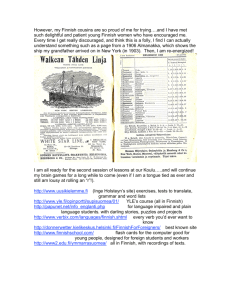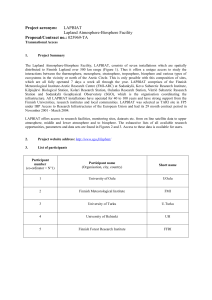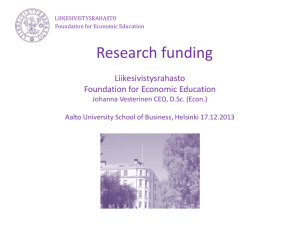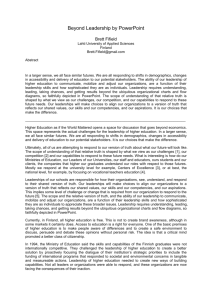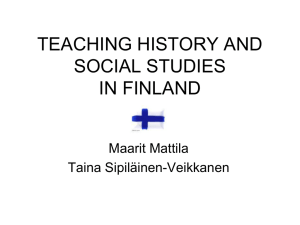Ei dian otsikkoa
advertisement
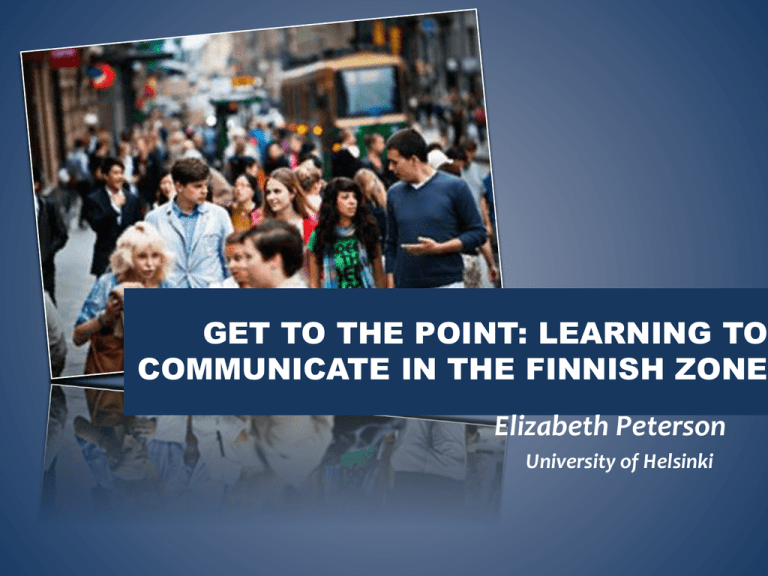
GET TO THE POINT: LEARNING TO
COMMUNICATE IN THE FINNISH ZONE
Elizabeth Peterson
University of Helsinki
OVERVIEW
Communication in Finnish -- Peterson
• my very own Fulbright project, 20002001 (Peterson 2004, my PhD)
• a few key findings about linguistic
politeness in Finnish
• metalinguistic data from Finnish
speakers
• current research on anglicisms in Finnish
discourse
2
LINGUISTIC
POLITENESS
Communication in Finnish -- Peterson
≠ ettiquette
≠ manners
≠ ‘please’ and ‘thank you’
not entirely, anyway
for a linguist, politeness = a specific
culture’s behavioral norms (House 2005)
there is no such thing as an “impolite”
culture
we do not say that one culture is “more
polite” than another
each culture has its own culturally
specific ways of encoding politeness
3
QUESTIONS
IN MY
RESEARCH
• What kind of factors are Finnish
people sensitive to in a
communicative event?
traditional values of power, distance,
and rate of imposition (of requests)
(Brown and Levinson 1978, 1987)
• Are there signs of variation?
if yes, then we know that there are
specific rules of politeness in Finnish
Communication in Finnish -- Peterson
4
WHAT LINGUISTIC TOOLS HELP SHOW POLITENESS?
(OR MITIGATION?)
English
Finnish
•
•
•
interrogative: Can I?
command: Give me
hint: That smells
good.
request type
modal verbs
•
•
•
Can I?
May I?
Can you?
verb tense/mood
•
•
Can you give me?
Could you give me?
politeness markers
2nd person address
request type
•
•
•
interrogative:
Annatko?
command: Anna.
hint: Tuoksuu
hyvältä.
modal verbs
•
•
•
Voinko?
Saanko?
Voitko?
verb tense/mood
•
•
Voitko antaa?
Voisitko antaa?
please, thank you
politeness markers
kiitos, -han/hän
thou, you, ya’ll, youse,
etc.
2nd person address
sinä, te
Communication in Finnish -- Peterson
5
METHOD
Communication in Finnish -- Peterson
• sociolinguistic interviews and
discourse completion tasks
with 68 native speakers of
Finnish
• results analyzed both
quantitatively (multivariate
analyses) and qualitatively
(through broad
transcription)
6
Social power and semantic formula
70
60
50
40
30
20
10
0
=P
+P
voida "can you"--most "polite"
interrogative "Annatko?"--least "polite"
saanko "May I?"
Communication in Finnish -- Peterson
7
Social distance and request type
80
70
60
50
40
30
20
10
0
-D
+D
Voida "Can you?" -- most "polite"
Interrogative, "Annatko?" Least "polite"
saanko 'may I?'
Communication in Finnish -- Peterson
8
Rate of imposition and request type
100
80
60
40
20
0
-R
+R
Voida "Can you" --most "polite"
Interrogative "annatko?" -- least "polite"
Saanko 'may I?'
Communication in Finnish -- Peterson
9
Use of conditional
P, D, R values and conditional verbs
90
80
70
60
50
40
30
20
10
0
Less {P, D, R}
Power
Distance
Communication in Finnish -- Peterson
More {P, D, R}
Rate of imposition
10
Social distance and ”you”
100
90
80
70
60
50
40
30
20
10
0
-D
formal te
D
informal sinä
Communication in Finnish -- Peterson
+D
none "Would it be possible to ..."
11
ROUND UP
Communication in Finnish -- Peterson
• What kind of factors are Finnish
people sensitive to in a
communicative event?
distance is important, power seems
to throw them off, and rate of
imposition (of requests) leads them to
all sorts of extra verbiage they would
be quick to deny…
• Are there signs of variation?
oh yes
• What do we know then?
that Finnish has culturally-specific
rules of politeness
12
POLITENESS IN
FINLAND
(YLI-VAKKURI,
2006)
”EVASION AT ALL
COSTS”
• Finnish politeness is withdrawing and evasive
• modesty, a wish to remain inconspicuous
• may even mistrust or be embarrassed by overt
politeness or flattery
• conversation begins only after formal
introductions
• politeness forms are based mostly on loans
from other languages; therefore ”common”
people may consider them artificial or
humiliating (hegemenous)
Communication in Finnish -- Peterson
13
PART 2 OF MY
DISSERTATION
RESEARCH
• What do Finnish people say
about themselves and their
language and customs?
Four major themes...
Communication in Finnish -- Peterson
14
1. FINNISH
HONESTLY
PRECLUDES
SMALL-TALK
AND OTHER
SUCH
FRIVOLITIES
Communication in Finnish -- Peterson
• “I think that in Finnish we go straight to
the point. In English you have all these
words that might make it softer, but
they don’t mean anything. But our
culture is maybe such that we don’t have
such little chat … but it depends on the
way you were raised, what sort of family
you come from, what sort of manners
you have.” (51-year-old female)
15
2. FINNS
ARE LAWABIDING
Communication in Finnish -- Peterson
“We are used to obeying all sorts of
rules. All sorts of these regulations
and directives that the EU makes,
Finland is always the first to do them,
and on time! In all the media, it is
reported how Finns did this without
any criticism at all! Sometimes I feel
like the whole EU is just laughing at
Finns and how they go and do all the
things without even questioning.”
(29-year-old female)
16
3. THE
TIMES THEY
ARE A –
CHANGING ...
AND SO IS
OUR
LANGUAGE
“I would say that we in Helsinki are
less cordial than most people in
Europe … Politeness has grown in
the last 10 to 25 years, maybe
because we want to be more
European. More … sivistynyt
(‘civilized’). I think Finnish people try
to treat strangers better than they
treat other Finns. They try to be more
polite.” (27-year-old male)
Communication in Finnish -- Peterson
17
4. THE (LACK
OF)
IMPORTANCE
OF
LINGUISTIC
POLITENESS
Communication in Finnish -- Peterson
“[In Finland], when you bump into somebody,
you don’t say ‘excuse me.’ You say, ‘oh-ho!’ –
and that’s already a lot! It doesn’t matter.”
(38-year-old female)
18
LANGUAGE
VS.
LANGUAGE
USE:
POLITENESS
Communication in Finnish -- Peterson
• “In Finnish, if you say kiitos, it
really means ‘please.’ You can’t use
it all the time like you do in English.
Or maybe I could say ‘Voisitko olla
hiljaa?’ [‘Could you be quiet?’], and
the please is in the conditional
verb.” (31-year-old female)
– backs up quantitative results
• criticism of the use of please in
English: “you use it all the time.”
19
MY MOST
CURRENT
RESEARCH
Communication in Finnish -- Peterson
• my obsession with ”the
magic word”
• anglicisms in Finnish
20
pliis ‘please’
Paunonen & Paunonen (2000):
• pliis first used in 1944
• Suomisen Olli rakastuu (‘Olli Suominen
falls in love’), by Orvo Saarikivi
Communication in Finnish -- Peterson
21
an index of
popular~youth
culture engagement
Yeah, put on some
hot music, please!
Communication in Finnish -- Peterson
22
SOME RECENT
OBSERVATIONS
2014: MORE THAN A MILLION
GOOGLE HITS ON ’PLIIS’
ad campaign for Helsinki Transit 2012
“Keep minimum wage, pliiiiiis”
University student demonstration in
downtown Helsinki, March 18, 2010
Communication in Finnish -- Peterson
unlike jees ’yes,’
not yet in official
Finnish
dictionaries23
“NEW” VS
“OLD”
POLITENESS
MARKERS IN
FINNISH
kiitos and pliis: (Peterson & Vaattovaara 2014)
• syntactically: pliis preferred clause medially;
kiitos clause finally
• semantically/pragmatically: different types of
utterances/intention
• regionally and socially: pliis is associated with
young, urban women
– but is used to a significant extent by
men, as well
• kiitos serves as a marker of negative
politeness, whereas pliis serves as a marker
of positive politeness
– a gap in the pragmatic system of Finnish?
Communication in Finnish -- Peterson
24
ABOUT
‘about’
• preposition, adverb
• semantic overlap in Finnish with
standard form noin
• about also behaves in ways that do
not overlap with English ’about’ or
Finnish noin
(Nykopp 2013)
Communication in Finnish -- Peterson
25
OH MY
GOD!
• standard Finnish form herranjumala,
minun luojani
– BUT, the forms are
pragmatically and semantically
distinct from each other; NOT
variants
• like in English, semantically
bleached
• less integrated than pliis and about?
– but, note [omg]
(Antturi 2104)
Communication in Finnish -- Peterson
26
Oh my god, must tuntuu et joku tulee
tonne huoneeseen jat sit se on
silleen omg te tapoitte hänet.
’oh my god, I feel like someone is
going to walk into that room and
he’ll be like, ’omg, you killed her.’
(Antturi 2014)
Janice, a character from the
American TV series Friends
Communication in Finnish -- Peterson
27
WHAT
WORKLOAD DO
THESE FORMS
SHARE IN
FINNISH?
social: young, global,
urban
pragmatic: low social
distance, solidarity,
informality
example 1: Deputy Mayor of Helsinki (December 2012)
Communication in Finnish -- Peterson
28
“The burgers were quite all right, but who ever heard
of being charged 1.50 euros for water in Finland
without even being told in advance?”
“Yeah, and the staff that brings you the glass costs
nothing? You can and may complain, but you have to
have a reason. At home it’s free. Not in a restaurant.”
example 2: Finnish celebrity chef, June
2013: ”Watergate”
Anglicisms in Finnish -- Peterson
29
WHAT IS THE TRAJECTORY?
codeswitch?
borrowing
urbanness,
globalism,
youth
further adaptation
urbanness,
globalism,
youth
grammatically
Finnish;
pragmatically
Finnish
Anglicisms in Finnish -- Peterson
30
TAKE-HOME
MESSAGE
Communication in Finnish -- Peterson
• it’s a different country, with different
cultural norms. Their aptitude in English
might throw you off, but for many
people, knowledge of English does not
equal knowledge of American or
English cultural norms.
• for many Finns, even their English can
be used in a ”Finnish” way when it
comes to conversational norms,
pragmatics and politeness
31
Thank you!
my contact information:
elizabeth.peterson@helsinki.fi
Downtown campus, Metsätalo,
6th floor, B wing, room 626
Communication in Finnish -- Peterson
32
Antturi, S. (2014). "Oh my god oh my god oh my god! mä en saa henkee!"
English interjection in Finnish discourse. University of Helsinki: Department
of Modern Languages.
Brown, P. and S. Levinson. (1987) Politeness: Some universals. Cambridge.
Nykopp, L. (2013). "Sanamuoto about näin": the use of about in Finnish
discourse. University of Helsinki: Department of Modern Languages.
Paunonen, H.;& Paunonen , M. (2000). Tsennaaks Stadii, bonjaaks slangii. Stadin
slangin suursanakirja. [The dictionary of Helsinki slang]. Helsinki: WSOY.
Peterson, Elizabeth. 2010. Perspective and politeness in Finnish requests.
Pragmatics 20 (3). 401–423.
Peterson, E. (2009). “It’s Just Different”: Emotions and Observations about
Finnish and English. Helsinki English studies : electronic journal of the
Department of English at the University of Helsinki. 5
Peterson, E.;& Vaattovaara, J. (2014). Kiitos and pliis: the relationship of native
and borrowed politeness markers in Finnish. Journal of Politeness Research
Yli-Vakkuri, Valma. 2005. Politeness in Finland: Evasion at all costs. In Leo
Hickey and Miranda Stewart (eds.), Politeness in Europe. Clevedon, UK:
Multilingual Matters.
Communication in Finnish -- Peterson
33
